
Latest news reports and images from Mars
Edition 4...August 2006 Published by www.Rockhoundstation1.com Hellas City; Mars
"FIRST HUMAN MISSION ON MARS: "
Journey to the Centre of Mars!
Aquarius Expedition...Mars.

Sponsors of the Aquarius Expedition: Destination the interior of the planet Mars ...
click the image to enlarge
Hello World Indiana here ...How are you doing? If you read edition 3 of the Chronicle (you can read it by clicking the link at the bottom of this page. or...Click Here ) You will know that Optica and I discovered lake Aquarius first surface water found on Mars and lake Xanadu a vast expanse of water below the surface of Mars...Well the expedition organisation is under way, all should be ready in about a month. then we shall discover the secrets of the interior of Mars.
"The water question. How to procure water enough to support life would be the great communal problem of the day."
Quoted from the book "Mars", published in 1895. -Percival Lowell
Well I think thats that question is now solved Percival; "fancy a swim" -O).
No, really you could swim in lake Xanadu its 13�C however quite frankly I have no idea what is in the lake, until I know more about it I will refrain from water sports. Tests show no bacterial or organic presence in the water yet that does not mean that there is not some sort of large martian dinosaur shark waiting for unsuspecting bathers. Mind you, Optica did fall in and was not "eaten up" if any large life form inhabits the lake I have no idea what it would eat? Need to send a robot to the lake bed to have a walk around and drones to scan the lake from above.
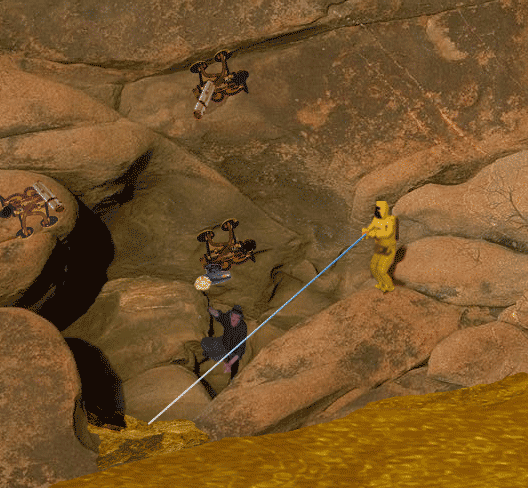
Exit of lake Aquarius and entrance to the labyrinth of of underground caverns leading to lake Xanadu on Mars.
The robot on the right is taking laser readings for future reference.
Gecko's ( climbing robots) capturing images and providing light for the interior.
Special report from the plain of Acidalia: Mars.

Welcome to Planitia Acidalia: Mars.
Click image to enlarge.
What part of Mars are we looking at? This chart is in relationship with Hellas City, capital of Mars.
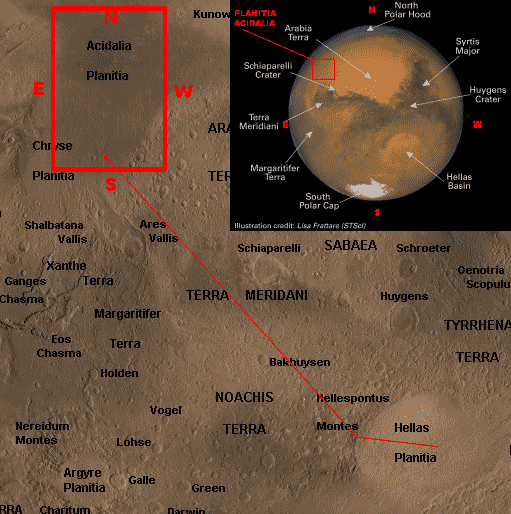
Were we are in relation to the Hellas crater.
As I had 5 days to wait before the railway and the Mars express reached Acidalia I decided to explore the plain of Acidalia. This area of Mars is the home of many strange anomalies photographed by NASA's Mars missions. They include the giant head on mars, the Acidalia temple complex as well as the glass worms. ...If you wish to learn more about these mystery's I am handing that task over to Johnny Danger he will tell you all about them. (Just click the name to discover more)
With about a hundred assorted robots and droids I set out to the north east across the Acidalia Planitia.
Now knowing that probably just below the surface of the plain of Acidalia were caves, rivers, and lakes changed my whole perception of the terrain I traversed. I experienced the sensation of walking on a roof or ice not the ground , as we advanced across Acidalia I saw more and more evidence of the vast complex of caverns that lay below the surface of Mars.
Whole areas some 2 to 3 kilometers (1-2 miles) in length had collapsed into the subterranean caverns , the depth of holes varied from deep to extremely deep.
Soon great holes began
to riddle the plain with cracks, fissures, crevasses impedeing our passage. As we circumnavigated these gaping chasms our progress resembled that of an Arctic expedition on earth...
What was most striking about the collapsed sections was that they had collapsed in a rythm, a pattern, as if some great shock wave had reverberated, rippling the ground, a sort of domino effect, as when in a line of standing dominos the first one falls then the next and the next in a regular pattern or rythm. This was clearly visible when observing the cavern floors from the surface above the collapsed sections.
Instead of simply crashing into the cavern as the law of gravity predicts the debris was piled into ridges at almost regular distances apart as if the debris was thrown forward then suddenly dropped to the floor in huge piles, I noted that all the ridges were thrown to the east. The water had been dammed by this action, thus the water had risen to form a lake then overflowed into the next section etc, etc, the water in the bottom of the collapsed section looked like series of locks on a canal with no lock gates, giving the appearance of squares or oblongs containing water over which sheet ice had formed giving it an eriee translucent reflective appearance.
In many collapsed areas vast quantities of sand has accumulated covering the ice save for the ridges of rubble which the wind keep clear. The water must have risen due to the displacement of the sand consequently the ridges of rock debris had become frozen tundra , the action of the wind and sand had smoothed the ice and polished it giving the whole scene the impression of the skeletal remains of a whales rib cage buried in sand yet thats were the resemblance ends as everything
was on a colosal, titanic scale. I could image only one cause for the destruction I observed in Acidalia.
The impact shock wave when the Hellas crater was formed.
Creation of the Hellas crater on Mars...

Moment of impact and pressure shock wave spreading; Hellas crater: Mars:
The Hellas crater on Mars was apparently created by a fragment of rock approximately the size of the largest asteroid,
Ceres, which is 578 miles (933 kilometers) in diameter.
The colosal fragment, is estimated to have hit Mars
a direct blow from the western quadrent of space,
at 25,000 mph (40,235 kph).
Which is 420 miles per minute (675 kpm),
7 miles per second (11 kps).
This impact would have created sudden, immense pressure waves
estimated to have traversed the interior of mars around 3,000 mph (4,828 kph).
Note:- Given the new definition of a planet by IAU's "planet definition committee" in Aug 06 and given the estimated figures of the impact object are correct it follows that the impact object that created the hellas crater was round unless it was a fragment of a larger body...QUOTE:
"Ceres by far the largest asteroid at 933 kilometres across, Ceres was called a planet when first discovered in 1801. But further findings of asteroids between the orbits of Mars and Jupiter led astronomers to class it with those smaller objects. A study last year of Hubble Space Telescope images proved that Ceres is round, placing it within the new definition."
AP. The Sydney morning Herald: August 16, 2006 - 12:34PM
Mars image credit: Hubble telescope.
That is the only cause I could think of to account for the enormous, systematic, rythmic, damage patterns to the cavern system in southern Acidalia ...
Now of course this is merely conjecture on my part.
Lake of orange ice... Lake Dante; Planitia Acidalia...Mars.
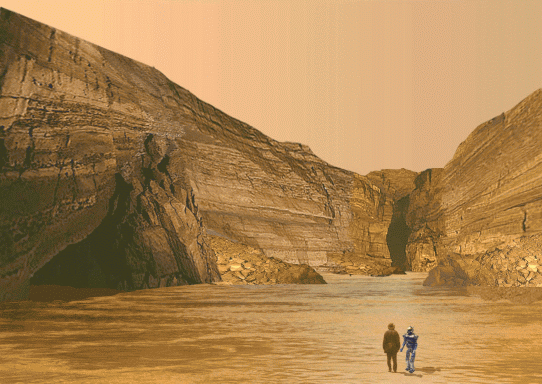
Talking to a robot on frozen lake Dante: Observe the missing centre of the ridge of rubble, perhaps this lake is water in the summer? At the moment the winter equinox has just passed here on Mars. The ridge has been cut and worn by the action of water which indicates that the water may not be permenantly frozen like the sand filled collapses.
click to enlarge
Satillite image: A Collapsed area filled with sand: ...Mars.
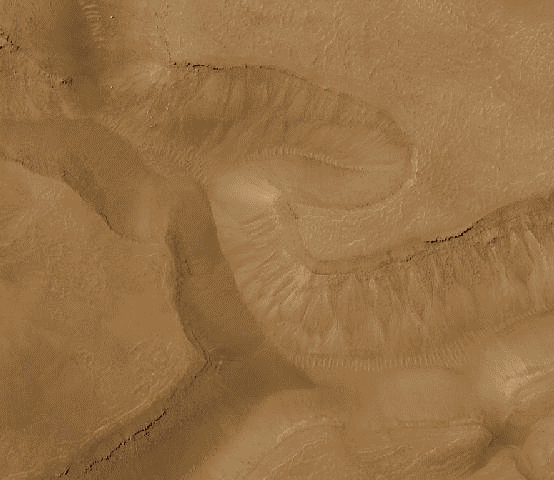
Image credit: Malin Space Science Systems. :

Virgil and Dante, Illustration from "The Divine Comedy" by Dante Alighieri Paris, Published 1885 by Gustave Dore
I descended 134 ft (40 meters) to the bottom of a very shallow subsidence, the base was ice tests showed it to be H�O, a frozen lake of water. Standing there on the ice I recalled the imagery of Dante"s "Inferno" and frozen lake Cocytus in the 9th circle of hell as described in his "Divine comedy" so I named the place "lake Dante".
The ice was orange from the reflected sky and rock creating the impression of fire beneath the ice. Yawning caverns all around lead away into the interior of Mars...I ventured into one of them to find my way blocked by the debris of fallen rock.
As it was not my intention to explore the interior of mars at this moment, I resumed my trek northward, my objective "The Acidalia temple complex" which held the promise of revealing more about the former or perhaps, present civilisation, on the Red planet.
Satillite image: The Acidalia Planitia temple complex; Mars (False colour).
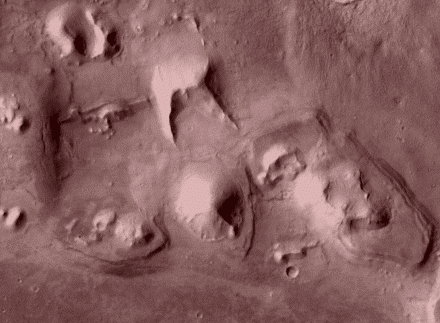
Objective: A group of features in Acidali Planitia that may be constructions...?
Image credit: Themis-data ASU.
Coming soon "Journey to the Centre of Mars"
UPDATE:- Pipeline: Lake Xanadu to Hellas

Bad news, I lost the contract for the pipe line to be constructed from the Hellas city to lake Xanadu, the 10,000 Kilometers of pipeline will now NOT be constructed...Mars light and Power intend to laser a tunnel from Hellas to Acidalia. The reason for this is dust, ML&P run a solar power grid, every time there is a dust storm at Hellas ...No power is generated and chemical combustion generators have to used. This is expensive . So ML&P have decided to construct a reservoir under Hellas to transfer the heat from lake Xanadu via an insulated tunnel. Heating is the main power consumption here on Mars. All surplus power in the grid will be used to heat the reservoir...talk about a pharonic project...The mind boggles-O)....
...So stay tuned...For more info from the Mars Chronicle, RHS1 News Service, Hellas, Mars.
Coming soon: Exclusive to the Mars Chronicle.

To learn more click the title above.
All the best...Indiana : August 2006 Mars
Your roving reporter for the Mars Chronicle
Optica

To boldly go were no dog has ever gone before!.

satellite image map of Mars .
..Click here

satellite image map of Mars . ..Click here

PurpleMatrixx : Global Matrixx free software .
..Click here

PurpleMatrixx : Global Matrixx free software . ..Click here
Back issues of the Mars Chronicle Edition 1:: Edition 2:: Edition 3::
Contact Sally Your Webmistress
Your page manager...Indiana : Mars











